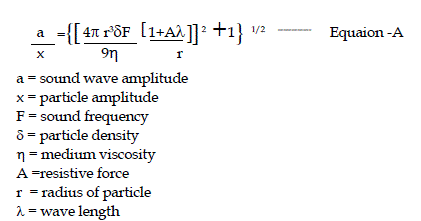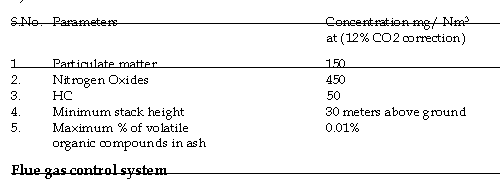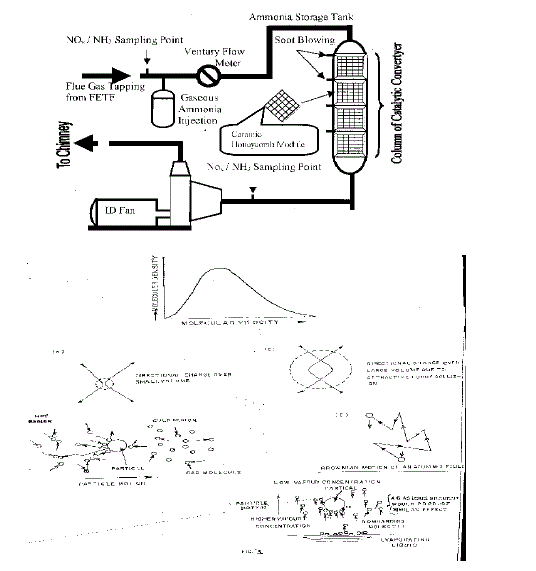Keywords
|
| |
| cupola, precipitator, E.M.I.D., Radiation, Ionisation |
| |
INTRODUCTION
|
| |
| The Clean air Acts of 1969 - 1970 and the establishment of emission standards for all types of gaseous industrial discharge have required levels of particulate considerably beyond its monitoring these practiced a decade earlier. People have talked enough regarding pollution and its monitoring but imaginative little about safeguarding our planet earth from this gigantic problems. The pollutants emanating from furnace, thermal power plants, cement plants, paper mills, stacks, brick kilns and burning of municipal waste mainly constitute SOx, CO (highly explosive & carcinogenic) and particulate matters ranging from 2.5 micrometer to 40 micrometer particle size. 67% of these sink due to gravity settling but 33% remains in suspended form and keeps moving either due to Brownian motion, temperature inversion, photo phoresis diffusion or electrophoresis phenomena. The dynamics of particle has been shown in Fig. 1 and a mathematical model has been developed from equation - A (Cunningham’s correlation) for non-continuous medium. |
| |
 |
| |
| These pollutants have deterimental physiological effect on biota of the affected region During winter these are also associated with smog formation. Particulate matter is also a major cause of visibility impairment in many parts of Asian countries and United States, because these particles scatter and absorb light. Besides, SOx and NOx appear as sulphuric and nitric acid i.e. acid rain, which not only corrode structures and historic monuments at the sight but also travel long distances across regional and international boarders. |
| |
| Cupola furnace mostly used in Mandi Gobindgarh, Morinda, Batala, Muktsar of Punjab and Agra, Firozabad and Muradabad in western UP (India) is a relatively high thermal efficient furnace in which melting of pig iron & cast iron is done using hard coke. Cupola furnace is an integral part of the foundry sector and has been identified as one of the major air polluting processes in foundry and forging technology. On an average, a cupola furnace with molten capacity of 2.75 to 3 tons/hour, releases flue gas volume of 9x103 to 1 1x103 Nm3/hour (550 -650°C), in which the SO2 range between 1000 to 2500 mg /Nm. The particle size distribution -diagram obtained from cement plants (Nimbahera, Rajasthan), Super thermal power plants, Ropar and paper mills, Ballarpur (Maharashtra) and Jagadhari (Haryana) reveal that most of them are coarser (nearly 50% particles are above 10 microns in size) |
| |
| In this manner a single cupola running for 8 hours a day emits about 25 to 45 kg of SO2 and 70 to 220 kg of particulate matter into the ambient air. |
| |
| Thus, we can well imagine the plight of people, who are working in Agra, Firozabad and Batala where 400-500 cupolas are under continuous operation and child-labour has become the mockery of Nation. Similar phenomena has been critically examined in the JK Cement industry, Nimahera, Rajasthan. Cement particles along with ash contents are released to the extent of 2000 mg/ Nm3, which traverses a long way within the periphery of residential colony till Chittorgarh. A passer by can observe the passing dust along with milky and scattering floodlight. If situation like this goes uncontrolled, it is bound to cause irrevocable damage to the sustainability of the atmosphere. Keeping the deteriorated ambient air quality in view, the Supreme Court had issued closuer orders to 21 5 cupolas in Agra alone. |
| |
Technology and control devices
|
| |
| In the quest to bring down the pollutant emissions well below the stipulated norms i.e 450 mg/Nm3 (particulate matter) for cupola furnace with a molten capacity less than 3 T/hour, Punjab state Council for Science & Technology has developed and demonstrated divided blast cupola along with a cost effective techno-economical, viable and workable technology for cupolas. It has been established that with modifications in air distribution system, and improved metallurgical practices, industry has obtained a profitable ratio of metal to coke as 1 0:1 . It means a direct saving of 90% coke and 54% pollution thrust. Further an improvement in metallurgical practices and optimal design features of divided cold blast cupola has also drastically minimized the pollution level at the source itself. |
| |
| In Fig. 2 and 3, the modified cupola refractory and recommended size of coke and limestone has been shown to minimize pollution load. |
| |
| Compared with conventional systems (1) multi cyclone (ii) wet scrubber (iii) Dust collector (iv) shower (v) Bag house, a low pressure scrubbing system in form of wet cap without using induced draft fan has been most successful apprehension to reduce flue gas emission in atmosphere. If the stack height is designed and raised according to given equation - 2, a reduction in flue gas emission has been noticed. Flue gas is passed and absorbed through bed of NH3, SO4, manomithynole amine, Die ethonyle amine or Tri-ethonylamine, NaSO4 and Ca (OH)2. H2S can be suppressed from releasing in atmosphere by passing it through the bed of ethanolemine and Soda ash. Here the absorbing bed of Dimethylamine, xyladine and water is affixed inside the outer neck of stacks. |
| |
 |
| |
| Apart from waste minimisation and reduction in pollution emission from biological and hospital - release, use of incinerators also curb the ambient pollution load to a greater extent |
| |
| The main Incinerator unit should be electrically operated and oil fired having pyrolytic system of burning of refuse with the capacity to burn 200 kgs of refuse per hour along with panel board, service tank, heat recovery system, Chimney for the flue gases, water storage tanks, oil storage tank, service tank, water and oil pipeline, electrical cables etc. Burner units, thermocouples, HT transfer photo resistor, air blower etc. should be complete in all respects with refractory lining of main burning unit. |
| |
Specifications
|
| |
| Main combustion and post combustion chamber; outer should be of 5 mm thick front sheet should be made out of M.S.Sheet of 10mm thickness with insulation thickness of minimum 75 mm of rock wool and calcium silicate. |
| |
Panel board
|
| |
| Panel board must be of suitable design with control switches for internal drought force and eductor fans, temperature indicator controller, safety devices, time switches, sensor controller etc. |
| |
| Each service tank should be made out of MS sheet of 5mm thickness mounted on suitable height of 3.5 mtrs. with the platform along with facility of ladder to reach up to the platform for inspection, Oil level indicator, heater (3KW) with thermostatic control, scour outlet for cleaning along with control valve and pipe, while inspection lid on the top of the tank of minimum 1 - 1> feet dia, with arrangements for locking the lid and inlet outlet pipeline with control valves. The joint should be welded and treated in such a manner that there is no leakage from the joints. |
| |
Heat recovery system
|
| |
| The temperature at the required point should be 70°C ± 5°C while cold and hot water tanks of 2,000 ltrs and 10,000 ltrs capacity respectively. Hot water line and hot water tank should be well insulated as per IS specifications/ IBR specifications, inlet-delivery pipe, pumps and control valves shall form a part of the Heat Recovery System. |
| |
a) Operating standards for incinerators
|
| |
| 1. The combustion efficiency (CE) shall be at least 99.00% |
| |
| 2. The combustion efficiency is computed as follows |
| |
 |
| |
b) Emission standards
|
| |
 |
| |
| Selective catalytic reduction system for minimizing NOX and particulate emission released as flue gases from coal fired thermal power plant station through stacks has been developed by Bharat Heavy Electrical (BHEL), Bangalore. This reduces the level of NOX by around 95%. In this process NOX concentration in flue gas is reduced through injection of ammonia in the presence of a catalyst at the optimum temperature between 3000C to 4000C, the reaction products are elemental Nitrogen and water vapour. Since the reaction is selective, the oxidation of ammonia and sulphur dioxide does not occur. The efficiency of NOX reduction depends on various factors such as NOX concentration at the inlet of the catalyst, flue gas temperature, the ratio of ammonia injection, oxygen concentration and catalyst properties composed of ceramic honeycomb module in a column of catalytic converter (Fig - 4). An increase in NH3 injection leads to increased NOX reduction, but the amount of ammonia, which reacts with Nitrogen oxide, depends on the activity of catalyst. Flue gas is tapped from a nodal point at fuel evaluation test facility (FETF) junction. The induced draft (ID.) fans draw the residue gas free from NOX to flow out of chimney. |
| |
 |
| |
| Use of electrostatic precipitator to convert micron particle to sub micron size and settling the same at the inner most base of electrostatic precipitator and later getting them removed through mechanical vibration is another safest, viable and techno economical solution to minimize and control the particulate emission in atmosphere. It has been shown in Fig - 5. |
| |
| In the electrostatic precipitators using high voltages, the dust particles are removed from dust laden air after passing the same through an array of parallel plates, with hanging, stainless steel wires maintained at high voltages. High voltages and electrical flux can be created by generating ionisation field through radioactive substrances in the electrostatic field inside the enclosed chamber of precipitator base. Thus, a low voltage precipitator itself serves the purpose of establishing highest ionization potential. High electrostatic field result in corona discharge through the dust-laden air, causing the dust particles to be electrically charged. The charged particles are thereby deposited on the array of parallel plates, causing clean air to flow out from the device. Here in the present invention, the dust particles are charged using a weak Strontium - 90 or TL - 1 (Thalium 204 sulphate in acqueous solution) of 1.05 millicurie intensity obtainable from Board of Radiation and isotope technology, BARC, Bombay. As the P - radiation from Thalium 204 (TL-1) ionizes the air producing +ve and -ve electrical charges, which immediately cling to the dust particles, there is no need of high voltage. It makes electrostatic precipitator highly efficient, techno economical to fulfill the users requirements. The polluted air is passed through activated silicagel granules to remove incoming odour, bad smell and further to create hygienic environment in auditorium hall and rooms. |
| |
Description of electrostatic precipitator
|
| |
| The device is a three compartment based instrument. The suction fan located to the left of the device draws in air. This flows through an array of parallel plates situated in the right portion of the device. These plates are fixed to the body of the precipitator through frame plates. Besides, air also flows through activated silicagel granules to remove odour. Also there is a prefilter made of jute cloth, mounted at the inlet portion of the precipitator. This prefilter removes majority of large size dust particles from the air. The fine particles are removed by the array of charged parallel plates. Also these fine particles are converted into submicron size due to ionization and particle collision among themselves. Each alternate plate is connected to a low DC Voltage of 100-500 V while the other plates are connected to ground potential. A thin layer of strontium -90/TL-l, Thallium - 204 radio active source is spread out on the base plate in which grooves are drawn to arrange the parallel plates array, made out of aluminum or stainless steel. The field in the outlet section of a highly efficient precipitator is dominated by the ionic space charge and thus cleans the room air to sub micron particle. |
| |
Specification of low voltage electrostatic precipitator
|
| |
| I. Range down to sub micron level |
| |
| II. High voltage and current indicator |
| |
| III. Fan out system, operating voltage 230 V, 50Hz with low power consumption. |
| |
| Such system are highly useful in air pollution control units like computer, telephone and sattelite assembly centers, Cupola furnaces, rice sellers, induction furnaces, Rolling mills, thermal power plants, cement and paper industries, water pollution control units like pharmaceuticals industries, Honey industry, Heat treatment units and electroplating industries. |
| |
Induction furnace: A source of pollution
|
| |
| On an average 800-2000 mg particle counter - 250 (Model Cl 250, Sr.No40519) reveals that 40% of the particulates are respirable in nature as PM 2.5 & PM 10 On an average 800-2000 mg /m3 dust mass emanates from induction furnances. |
| |
Technology for air pollution control in induction furnace
|
| |
| Two types of pollution control technologies have been developed, which depend on the quality of scrap used in the induction furnace. Self induced impingement type scrubber is used for clean scrap. Bil filters with cooling system for galvanized and oily scrap or are used for air pollution control. |
| |
| In self induced impingement type scrubbers, flue gas uses its dynamic forces by direct impingement on to a liquid surface, besides incorporating Venturi principle provided for gaseous acceleration during or prior to liquid impingement. |
| |
| In such scrubbers, consumption of water is negligibly small with pressure drop in the range of 10 - 15” water gauge. Such type of self induced scrubber handles most efficiently the high gas rates with large dust concentration. Here the gas flows with high velocity over the water surface through a stationary impeller while carrying the water in a turbulent sheet. The centrifugal force exerted due to rapid change in flow direction causes efficient water particle contact. The clean air flows upward over a de-entrainment baffle to induced draft fan. |
| |
Filteration technology for galvanized and oily scrap
|
| |
| Here the choice of fabric usually depend on temperature of gas stream, physical and chemical characteristics of particles to be collected, chemical composition and moisture content of the carrier gas. Poly propylene fabric is the most appropriate choice as per the prevalent condition in the induction furnace. Before the hot gases are directed to bag houses, these are cooled down to 100 -120°C temperature in case of polypropylene fabric. A water to air heat exchanger is the suitable option for induction furnaces. Heat exchanger causes 1.5 to 2” pressure drop in the total system. |
| |
| In the filteration technology, flue gases are made to enter at the bottom in a hopper and flow through the filter fabric along its sides, leaving the dust to form a cake inside the bags and finally flows out of the bags to escape the duct. Mechanical vibration and forced shaking does cleaning of bags and dust is collected in the bottom hopper. Sometimes a slurry form of dust is also obtained after showering the flowing dust through bags. After every melting cycle operation, the shaker is operated for few minutes and dust is taken out of bottom hopper by operating the rotary air lock valve. |
| |
Acknowledgement
|
| |
| I am thankful to Director CSIO who allowed us to develop these control systems under our in house programme. I also owe a special thanks to all my colleagues of EMID to complete this instrument in the wake of time. |
| |
References
|
- Prasad Basudeo, 1993. Measurement of inhalable particulates and its effect. Report no. CSIO/TR/93/0046.
- Saskatchewan, 2003. Environment report - environment protection branch Canada. Air Pollution Control Technology for Cupola Furnace (leaflet) 2004. Publisher Punjab State Council for Science & Technology, Chandigarh.
- Bhatnagar, V.S., 1990. Report on low voltage electrostatic precipitator. C.S.I.R. News, 2004. ISSN 0409-7467. 54 : 13 &14 15 & 30.
- Engineering News Letter, 2005. BHEL, Bangalore. 28 : 1.
- Municipal Solid waste (Management and Handling - Rules, 2000) CPCB, New Delhi, July 2003 Page - 48.
|